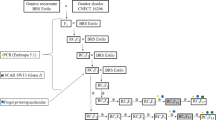Abstract
A series of field experiments was undertaken in order to determine whether resistance to bean common mosaic virus (BCMV) could be incorporated into genotypes of the common bean (Phaseolus vulgaris L.) suitable for cultivation in Zimbabwe without recourse to backcrossing. Six inbred genotypes carrying the resistance-conferring alleles at the loci I and Bc-3 were crossed with five locally-adapted inbred genotypes. The first experiment comprised F3 progeny rows, each derived from a single unselected F2 plant, the second, F3 bulks selected for resistance, and the third, a comparison of selected and unselected F2-derived F4 lines. The number of days to flowering and to maturity, the incidence of mosaic and necrosis symptoms, seed yield and seed size were recorded. There was evidence that late flowering and maturity were associated with BCMV resistance in some crosses, though not strongly enough to present an obstacle to plant breeding. The incidence of virus symptoms and seed yield were influenced by genetic factors additional to the major resistance genes, and variation in seed yield was present not only between bulk populations of crosses, but also between single-row plots of lines within crosses. This indicates that early-generation selection for yield in the presence of BCMV, even among progeny selected for BCMV-resistace, is likely to be effective. However, the variation in yield among F4 lines was least in the highest-yielding crosses, which may represent a limit to successful selection for yield. Seed size was partly under additive genetic control, but there was also evidence of non-allelic interactions. There was no association between large seed size, preferred by consumers, and susceptibility to BCMV in the progeny, indicating that the association between these characters in the parent lines is fortuitous and will not present an obstacle to plant breeding. It is noted that a considerable amount of useful genetic information can be obtained without recourse to elaborate crossing schemes, provided that unselected progeny are included in experiments as controls. The evidence presented indicates that resistance to BCMV can be combined with appropriate values of maturity date, yield and seed size without the need for backcrossing.
Similar content being viewed by others
References
CIAT, 1987. Standard system for evaluation of bean germplasm. A. van Schoonhoven and M.A. Pastor-Corrales (compilers). Cali, Colombia. 54 pp.
Drijfhout, E., 1978. Genetic interaction between Phaseolus vulgaris and bean common mosaic virus, with implications for strain identification and breeding for resistance. Agricultural Research Reports, No. 872. Centre for Agricultural Publishing and Documentation, Wageningen, the Netherlands.
Hamblin, J., 1977. Plant breeding interpretation of the effects of bulk breeding on four populations of beans (Phaseolus vulgaris). Euphytica 26: 157–168.
Hamblin, J. & C.M.Donald, 1974. The relationship between plant form, competitive ability and yield in a barley cross. Euphytica 23: 535–542.
Hamblin, J. & A.M.Evans, 1976. The estimation of cross yield using early generation and parental yields in dry beans (Phaseolus vulgaris L.). Euphytica 25: 515–520.
Jennings, P.R. & R.M.Herrera, 1968. Studies on competition in rice. II. Competition in segregating populations. Evolution 22: 332–336.
Mukoko, O.Z., 1992. Breeding beans (Phaseolus vulgaris L.) for resistance to bean common mosaic virus in Zimbabwe. Ph.D. thesis. University of Cambridge, England.
Mukoko, O.Z., N.W. Galwey & D.J. Allen, in press. Developing cultivars of the common bean (Phaseolus vulgaris L.) for Zimbabwe: BCMV resistance, consumer preferences and agronomic requirements. Accepted by Field Crops Research.
Nienhuis, J. & S.P.Singh, 1988. Genetics of seed yield and its components in common bean (Phaseolus vulgaris L.) of middle-American origin. II. Genetic variance, heritability and expected response from selection. Plant Breeding 101: 155–163.
Ramalho, M.A.P., J.B.dos Santos & I.Pereira-Filho, 1988. Choice of parents for dry bean (Phaseolus vulgaris L.) breeding. I. Interaction of mean components by generation and by location. Rev. Bras. Genet. 11: 391–400.
Simmonds, N.W., 1979. Principles of Crop Improvement. Longman, London. 408pp.
Singh, S.P., R.Lepiz, J.A.Gutierrez, C.Urea, A.Molina & H.Teran, 1990. Yield testing in early generation populations of the common bean. Crop Sci. 30: 874–878.
Sneep, J., 1977. Selection for yield in early generation of self fertilising crop. Euphytica 26: 27–30.
Temple, S.R. and F.J.Morales, 1986. Linkage of dominant hypersensitive resistance to bean common mosaic virus to seed colour in Phaseolus vulgaris L. Euphytica, 35: 331–333.
Author information
Authors and Affiliations
Rights and permissions
About this article
Cite this article
Mukoko, O.Z., Galwey, N.W. Breeding the common bean (Phaseolus vulgaris L.) for resistance to bean common mosaic virus: alternatives to backcrossing. Euphytica 82, 91–104 (1995). https://doi.org/10.1007/BF00027055
Received:
Accepted:
Issue Date:
DOI: https://doi.org/10.1007/BF00027055




